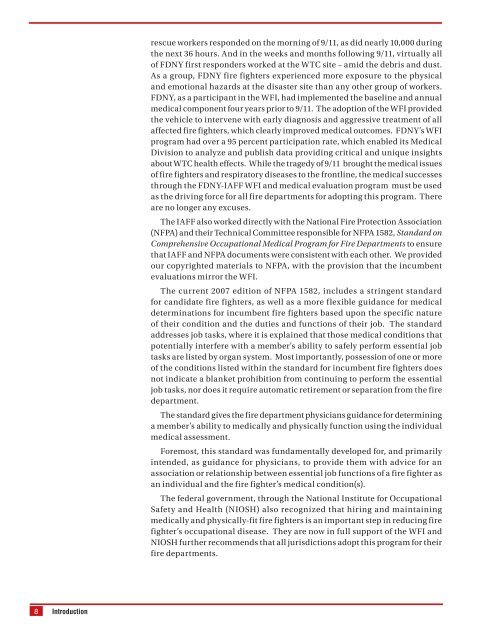Respiratory Diseases and the Fire Service - IAFF
Respiratory Diseases and the Fire Service - IAFF
Respiratory Diseases and the Fire Service - IAFF
Create successful ePaper yourself
Turn your PDF publications into a flip-book with our unique Google optimized e-Paper software.
8<br />
Introduction<br />
rescue workers responded on <strong>the</strong> morning of 9/11, as did nearly 10,000 during<br />
<strong>the</strong> next 36 hours. And in <strong>the</strong> weeks <strong>and</strong> months following 9/11, virtually all<br />
of FDNY first responders worked at <strong>the</strong> WTC site – amid <strong>the</strong> debris <strong>and</strong> dust.<br />
As a group, FDNY fire fighters experienced more exposure to <strong>the</strong> physical<br />
<strong>and</strong> emotional hazards at <strong>the</strong> disaster site than any o<strong>the</strong>r group of workers.<br />
FDNY, as a participant in <strong>the</strong> WFI, had implemented <strong>the</strong> baseline <strong>and</strong> annual<br />
medical component four years prior to 9/11. The adoption of <strong>the</strong> WFI provided<br />
<strong>the</strong> vehicle to intervene with early diagnosis <strong>and</strong> aggressive treatment of all<br />
affected fire fighters, which clearly improved medical outcomes. FDNY’s WFI<br />
program had over a 95 percent participation rate, which enabled its Medical<br />
Division to analyze <strong>and</strong> publish data providing critical <strong>and</strong> unique insights<br />
about WTC health effects. While <strong>the</strong> tragedy of 9/11 brought <strong>the</strong> medical issues<br />
of fire fighters <strong>and</strong> respiratory diseases to <strong>the</strong> frontline, <strong>the</strong> medical successes<br />
through <strong>the</strong> FDNY-<strong>IAFF</strong> WFI <strong>and</strong> medical evaluation program must be used<br />
as <strong>the</strong> driving force for all fire departments for adopting this program. There<br />
are no longer any excuses.<br />
The <strong>IAFF</strong> also worked directly with <strong>the</strong> National <strong>Fire</strong> Protection Association<br />
(NFPA) <strong>and</strong> <strong>the</strong>ir Technical Committee responsible for NFPA 1582, St<strong>and</strong>ard on<br />
Comprehensive Occupational Medical Program for <strong>Fire</strong> Departments to ensure<br />
that <strong>IAFF</strong> <strong>and</strong> NFPA documents were consistent with each o<strong>the</strong>r. We provided<br />
our copyrighted materials to NFPA, with <strong>the</strong> provision that <strong>the</strong> incumbent<br />
evaluations mirror <strong>the</strong> WFI.<br />
The current 2007 edition of NFPA 1582, includes a stringent st<strong>and</strong>ard<br />
for c<strong>and</strong>idate fire fighters, as well as a more flexible guidance for medical<br />
determinations for incumbent fire fighters based upon <strong>the</strong> specific nature<br />
of <strong>the</strong>ir condition <strong>and</strong> <strong>the</strong> duties <strong>and</strong> functions of <strong>the</strong>ir job. The st<strong>and</strong>ard<br />
addresses job tasks, where it is explained that those medical conditions that<br />
potentially interfere with a member's ability to safely perform essential job<br />
tasks are listed by organ system. Most importantly, possession of one or more<br />
of <strong>the</strong> conditions listed within <strong>the</strong> st<strong>and</strong>ard for incumbent fire fighters does<br />
not indicate a blanket prohibition from continuing to perform <strong>the</strong> essential<br />
job tasks, nor does it require automatic retirement or separation from <strong>the</strong> fire<br />
department.<br />
The st<strong>and</strong>ard gives <strong>the</strong> fire department physicians guidance for determining<br />
a member’s ability to medically <strong>and</strong> physically function using <strong>the</strong> individual<br />
medical assessment.<br />
Foremost, this st<strong>and</strong>ard was fundamentally developed for, <strong>and</strong> primarily<br />
intended, as guidance for physicians, to provide <strong>the</strong>m with advice for an<br />
association or relationship between essential job functions of a fire fighter as<br />
an individual <strong>and</strong> <strong>the</strong> fire fighter’s medical condition(s).<br />
The federal government, through <strong>the</strong> National Institute for Occupational<br />
Safety <strong>and</strong> Health (NIOSH) also recognized that hiring <strong>and</strong> maintaining<br />
medically <strong>and</strong> physically-fit fire fighters is an important step in reducing fire<br />
fighter’s occupational disease. They are now in full support of <strong>the</strong> WFI <strong>and</strong><br />
NIOSH fur<strong>the</strong>r recommends that all jurisdictions adopt this program for <strong>the</strong>ir<br />
fire departments.

















